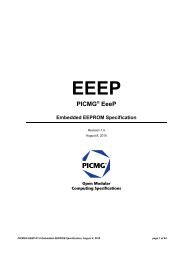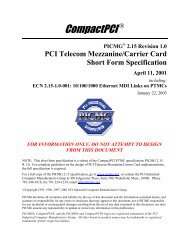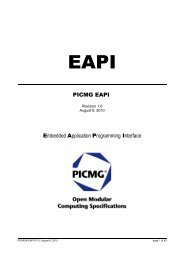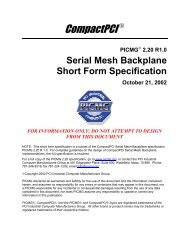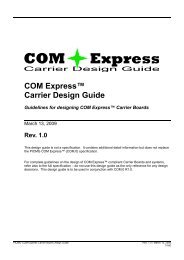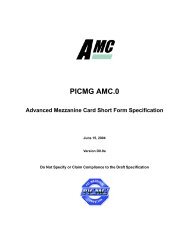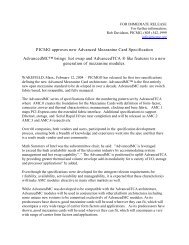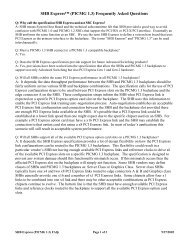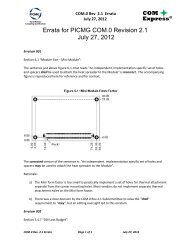PICMG 2.16, CompactPCI Packet Switching Backplane
PICMG 2.16, CompactPCI Packet Switching Backplane
PICMG 2.16, CompactPCI Packet Switching Backplane
Create successful ePaper yourself
Turn your PDF publications into a flip-book with our unique Google optimized e-Paper software.
<strong>PICMG</strong> ® <strong>2.16</strong> R1.0 Short Form Specification<br />
Node Boards<br />
Plug Into<br />
Node<br />
Slots<br />
Fabric Boards<br />
Plug Into<br />
Fabric<br />
Slots<br />
Fabric 'f' Link<br />
8 wire IEEE 802.3-2000 Compliant<br />
Fabric 'a' Links<br />
8 wire IEEE 802.3-2000 Compliant<br />
1 2 3 4 a b<br />
f f<br />
1 1<br />
Fabric Board<br />
Link Ports<br />
1 to N, and 'f'<br />
Node Board<br />
Link Ports<br />
'a' and 'b',<br />
a a a a<br />
b b b b<br />
2<br />
3<br />
4<br />
2<br />
3<br />
4<br />
Fabric 'b' Links<br />
8 wire IEEE 802.3-2000 Compliant<br />
Figure 6 Node/Fabric Slot Interconnect Example (6 Slots)<br />
Link Port ‘a’ of each Node Slot is connected to a Link Port of Fabric Slot ‘a’. Link Port ‘b’ of<br />
each Node Slot is connected to a Link Port of Fabric Slot ‘b’. Link Ports of Node Slot N are<br />
connected to Link Port N of Fabric Slots ‘a’ and ‘b’.<br />
Hot Swap Interoperability<br />
The <strong>CompactPCI</strong>/PSB Specification supports Hot Swap in several ways. <strong>PICMG</strong> <strong>2.16</strong> Boards<br />
and <strong>Packet</strong> <strong>Switching</strong> <strong>Backplane</strong>s may support only <strong>CompactPCI</strong>/PSB Link Ports or both the<br />
<strong>CompactPCI</strong> Bus and the <strong>CompactPCI</strong>/PSB Link Ports.<br />
A new signal, PCI_PRESENT#, is defined for use by <strong>CompactPCI</strong>/PSB Boards. This signal is<br />
allocated to the P1/J1 connector on pin B6. P1-B6 is defined as ground (GND) in <strong>PICMG</strong> 2.0<br />
R3.0. PCI_PRESENT# serves two purposes. It allows a board’s <strong>CompactPCI</strong> Bus interface to<br />
be appropriately configured when the <strong>CompactPCI</strong> Bus is not connected to the corresponding<br />
slot. In a Hot Swap environment, it partially determines when the board must locally manage the<br />
handle switch, Blue LED, ENUM# and quiescence of critical board resources. When low, this<br />
active-low signal indicates that the <strong>CompactPCI</strong> Bus signals are connected to the corresponding<br />
slot.<br />
The complete <strong>2.16</strong> specification defines <strong>CompactPCI</strong>/PSB Hot Swap requirements for<br />
<strong>Backplane</strong>s, Node Boards and Fabric Boards with Hot Swap capabilities. A <strong>CompactPCI</strong>/PSB<br />
Hot Swap Board can support only <strong>CompactPCI</strong>/PSB Link Ports or both the <strong>CompactPCI</strong> Bus<br />
and the <strong>CompactPCI</strong>/PSB Link Ports. A <strong>Packet</strong> <strong>Switching</strong> <strong>Backplane</strong> Slot can support only<br />
<strong>CompactPCI</strong>/PSB Links or both a <strong>CompactPCI</strong> Bus and the <strong>CompactPCI</strong>/PSB Links.<br />
<strong>PICMG</strong> <strong>2.16</strong> supports a superset of the High Availability functionality defined by <strong>PICMG</strong> 2.1.<br />
Not every implementation of <strong>PICMG</strong> <strong>2.16</strong> <strong>CompactPCI</strong> <strong>Packet</strong> <strong>Switching</strong> <strong>Backplane</strong>s or<br />
<strong>CompactPCI</strong>/PSB Hot Swap Node/Fabric Boards is necessarily interoperable with <strong>PICMG</strong> 2.1<br />
defined High Availability components.<br />
FOR INFORMATION ONLY;<br />
DO NOT ATTEMPT TO DESIGN FROM THIS DOCUMENT




